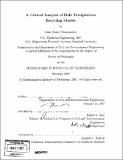A critical analysis of bulk precipitation recycling models
Author(s)
Fitzmaurice, Jean Anne
DownloadFull printable version (7.189Mb)
Other Contributors
Massachusetts Institute of Technology. Dept. of Civil and Environmental Engineering.
Advisor
Rafael L. Bras.
Terms of use
Metadata
Show full item recordAbstract
Precipitation recycling is the contribution of local land evaporation to the precipitation of a region. The significant local evaporative contribution to rainfall in many continental regions highlights the potential importance of land-atmosphere feedback. This thesis addresses three common assumptions in bulk precipitation recycling models: (1) the use of time-averaged data (2) the neglect of the atmospheric storage term and (3) the well-mixed assumption. Bulk precipitation recycling models have been criticized for their use of monthly mean data in estimating moisture influx, which does not capture the diurnal and synoptic variations important in hydrology. This work uses a method to compute moisture influx using the atmospheric data at the finest time-scale available. Smaller monthly recycling ratio estimates were found when using this new method. Most previous recycling studies are monthly. The atmospheric storage term is added to an earlier recycling model to study the submonthly time-scale. The southwest Amazon region during the wet season is investigated. There the synoptic conditions consist of alternating easterly and westerly regimes of three to fourteen day duration. The resulting recycling ratio spatial patterns are shown to reflect the synoptic circulation patterns. (cont.) Two parameters are introduced to relax the the well-mixed assumption in the Bras and Eltahir model. Information from a water vapor tracer study and atmospheric reanalysis data are used to estimate parameter values. Applying this model to the central United States region during the summer, using four years of data, finds 30 percent larger recycling ratios than those resulting from the original well-mixed assumption. This formulation is generalized to another bulk recycling model. A quantitative assessment of the quality of two atmospheric reanalysis datasets used as input to recycling models is also provided.
Description
Thesis (Ph. D.)--Massachusetts Institute of Technology, Dept. of Civil and Environmental Engineering, 2007. Includes bibliographical references.
Date issued
2007Department
Massachusetts Institute of Technology. Department of Civil and Environmental EngineeringPublisher
Massachusetts Institute of Technology
Keywords
Civil and Environmental Engineering.